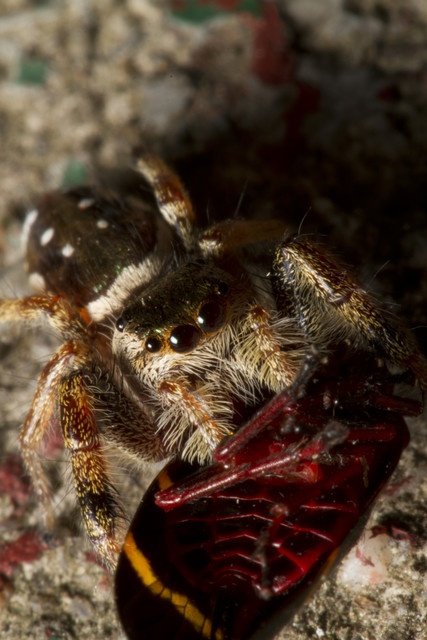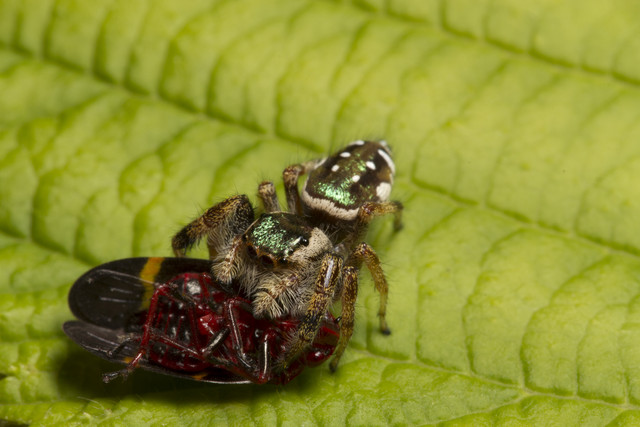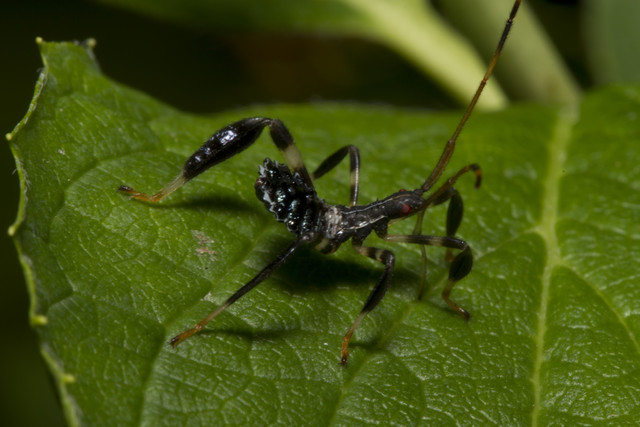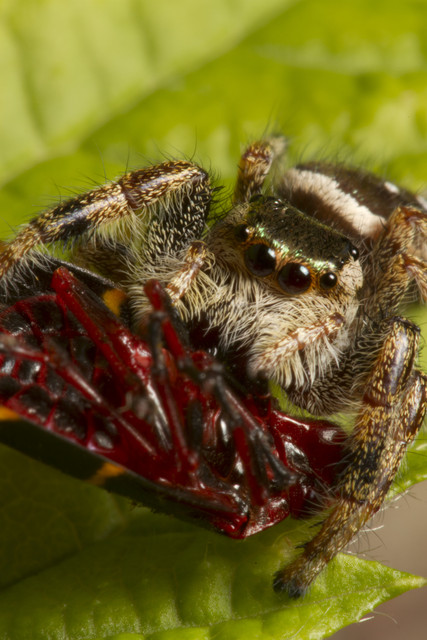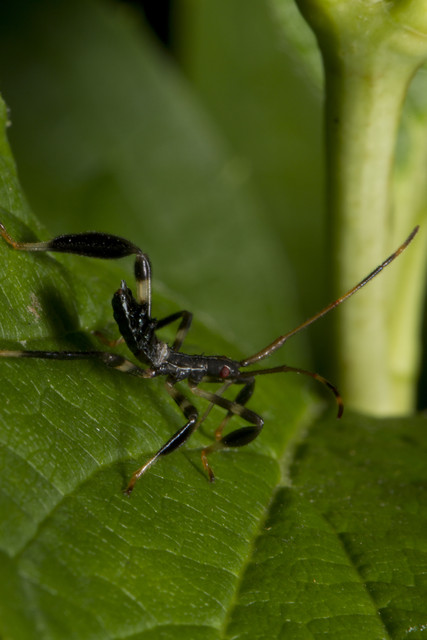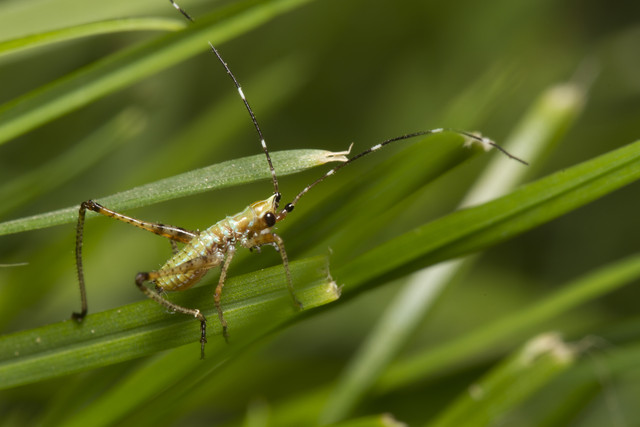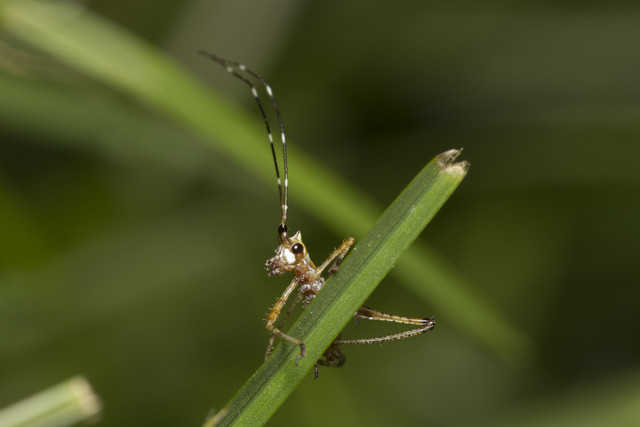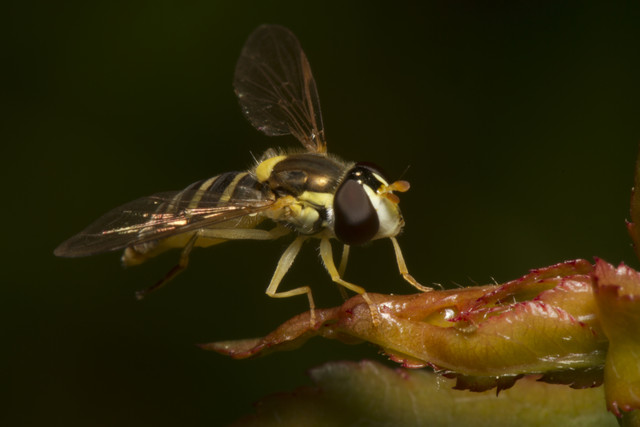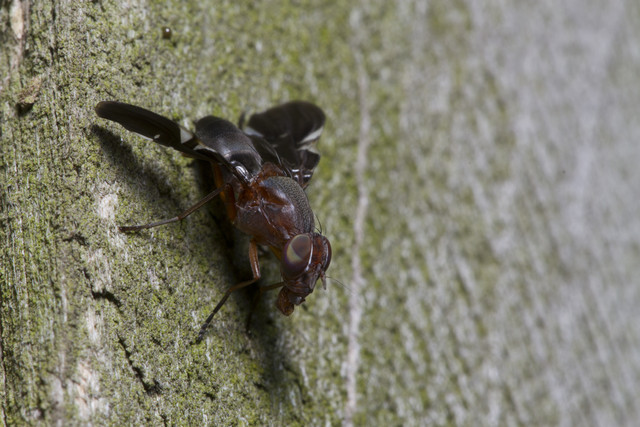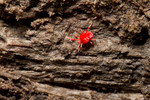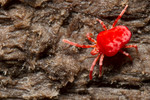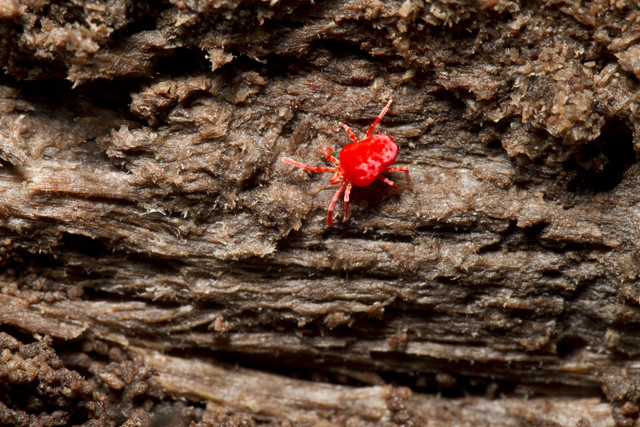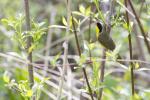insects
Poll: Jumping Spider Dinner (part 3)
ktuli — Wed, 07/13/2011 - 19:37
As I was working with this guy, I was trying many different angles - some because he would move around, some because I just wanted to get as many angles as possible before he got tired of having a camera shoved in his face.
When I tried this angle, my camera flash bracket put the flash to the side of the spider. I could have moved it, but then I thought about how a shot would look with the light coming from the side and producing this strong shadow on the other side of the spider.
Fortunately, it worked exactly as I had envisioned before clicking the shutter. The side lighting caused a very distinct shadow to the far side of the spider - producing an effect that makes the spider look much larger than he really is. In truth, because of the setup I was using (basically a 2:1 magnification), this spider was already looking pretty giant in the viewfinder. However, that big shadow just increases that feeling in my opinion.
I shared this on a forum I frequent, and received lack-luster responses to the usage of the flash in this manner. One suggestion was to use a reflector to bounce some of the flash light back into the right side. This probably would have still kept the distinct shadow, but would have helped to bring back some of the details on the right side of the spider.
I don't know if that would have really done much, or if I would have liked it better - I personally am very pleased with this shot and the feeling it produces for me.
Technical Data: Canon EOS 7D, Canon EF 100mm f/2.8L Macro IS USM with Kenko Teleplus PRO 300 "DG" AF 2x Teleconverter, 1/250 sec at f/16. Canon Speedlight 580EX II flash in auto mode and wireless control. Image Stabilization on. ISO 160. RAW processing in Adobe Camera Raw.
So cast your vote and let me know what you think... whether the strong shadow works, or if it ruins the image. Drop me a comment and let me know why you voted the way you did (sorry - no option will be provided for 'the spider ruined the image, not the shadow!'). Remember - you don't have to know all about photography to be able to vote on what you like...
Thanks for stopping by!
- Bill
Jumping Spider Dinner (part 2)
ktuli — Tue, 07/12/2011 - 19:06
Here's another of that jumping spider with his dinner. This one was taken without the teleconverter, so the magnification isn't as dramatic, but I feel this shot has a bit better composition than just a super-macro shot.
Technical Data: Canon EOS 7D, Canon EF 100mm f/2.8L Macro IS USM, 1/250 sec at f/16. Canon Speedlight 580EX II flash in auto mode and wireless control. Image Stabilization on. ISO 160. RAW processing in Adobe Camera Raw.
Why This Photo: When I found this little guy digging into his dinner, and saw what a cool jumping spider he was, I simply had to see what kind of shots I could manage with him.
What Works: The best item of this shot is the way the metallic green color shows up on the spider's body. This color only appeared on certain angles, so I did have to make some sacrifices to get it, but I think it was worth it. The DoF works to get almost the whole spider in clarity (only possible because of the light provided by the 580EX), and the focus is sharp right on the spider's face. And the bright green leaf produces a nice pleasing background.
What Doesn't Work: To get the green metallic color, I had to sacrifice getting the spider's face and eye contact (many of the other shots have great catchlights in the eyes). Also, the composition would probably have been better if the spider were in the upper right corner, but that simply depended on where the spider was on the leaf (in fact, the edge of the leaf shows in the very bottom left corner).
What do you think? Drop me a comment and let me know.
- Bill
Assassin Bug (part 2)
ktuli — Sun, 07/10/2011 - 17:23
As promised, here are a couple more shots of the ninja assassin bug (ok - that's not a technical name, but it sure looks like a ninja!).
Technical Data: Canon EOS 7D, Canon EF 100mm f/2.8L Macro IS USM with Kenko Teleplus PRO 300 "DG" AF 2x Teleconverter, 1/250 sec at f/22. Canon Speedlight 580EX II flash in auto mode and wireless control. Image Stabilization on. ISO 160. RAW processing in Adobe Camera Raw.
This first one was actually taken inside the light tent. I had trapped the bug in a small tupperware container and transported it to our light tent hoping to get some shots of it on a nice white background. Unfortunately, I think the bright lights really bothered it and it would not sit still for very long. I managed to get a few shots, but more of the time was spent trying to keep it from running away. After a bit, I decided that it was just far too stressed by the ordeal and transferred it back outside.
Fortunately, once it was out of the bright lights and back on a plant outside, it sat still very nicely. Unfortunately, it was 10PM at night, and already very dark outside. So capturing images of it was a challenge. Particularly, focusing was extremely difficult. I had to almost guess at the focus - using the outline of the bug against whatever light source I could find.
In the end, I was able to get a couple shots including the one I shared the other day and this one:
Technical Data: Canon EOS 7D, Canon EF 100mm f/2.8L Macro IS USM, 1/250 sec at f/22. Canon Speedlight 580EX II flash in auto mode and wireless control. Image Stabilization on. ISO 160. RAW processing in Adobe Camera Raw.
I was really glad that I was able to get some good shots of such an interesting subject - despite the difficulties presented.
- Bill
Jumping Spider Dinner (part 1)
ktuli — Sun, 07/10/2011 - 15:36
Ok - I am sorry to start another multi-part series right after beginning a different oe, but I found this little guy last night and really want to start sharing the photos. So I promise to get back to the assassin bug, but it will just be interspersed with this jumping spider.
I found this guy on a leaf on one of the plants out front. Because of where he was located, I simply decided to pinch off the leaf he was on and relocate him to the floor of our front porch. He had obviously just captured this insect (the legs were still twitching) he was starting to tuck into, so I wanted to be careful not to cause him to lose his meal. Apparently there was little risk of that. Over the twenty minutes or so that I was photographing him, he never once let go of it, and probably didn't ever stop eating (by the end, the bug was much smaller and shriveled).
As if typical for me these days, I shot these using the Speedlight 580EX II on a Siegelight bracket and Lumiquest Mini-Softbox and controlled wirelessly by the Canon 7D and my new favorite lens in the Canon EF 100mm f/2.8L Macro, and after a few initial shots with that setup - I usually toss in the Kenko 2x teleconverter. All told, the setup allows me to get shots that I never would have imagined possible before. The Canon 100mm lens provided some excellent image quality, and the image stabilization helps to let me shoot handheld (which I probably shouldn't do), while the flash allows me to stop down the aperture (often to f/16 or higher) for greater depth of field, and finally the teleconverter allows me get 2:1 (twice life-size) magnification.
What that all translates to is getting to see the culinary habits of jumping spiders in incredible detail - though I am sure there are those of you who don't think that is a good thing, but oh well. :)
Technical Data: Canon EOS 7D, Canon EF 100mm f/2.8L Macro IS USM with Kenko Teleplus PRO 300 "DG" AF 2x Teleconverter, 1/250 sec at f/16. Canon Speedlight 580EX II flash in auto mode and wireless control. Image Stabilization on. ISO 160. RAW processing in Adobe Camera Raw.
Stay tuned and I'll continue sharing shots of the assassin bug and this jumping spider.
- Bill
Assassin Bug (part 1)
ktuli — Fri, 07/08/2011 - 07:24
Ok - just a quick post because I want to share this... I found this guy yesterday and had to get a couple photos of him. I had found a larger one a couple weeks ago, but wasn't able to get any photos.
This is an assassin bug - I believe a sub-adult.
Technical Data: Canon EOS 7D, Canon EF 100mm f/2.8L Macro IS USM, 1/250 sec at f/22. Canon Speedlight 580EX II flash in auto mode and wireless control. Image Stabilization on. ISO 160. RAW processing in Adobe Camera Raw.
I will share more about assassin bugs and their behaviors as well as the challenges I faced taking these photos at a later time.
Thanks for stopping by.
- Bill
Poll: Katydid Nymph (part 3)
ktuli — Fri, 06/10/2011 - 06:40
So after looking at the shot from the other day, and thinking about the elements that I wished could have been improved with that shot, I decided that perhaps a simple crop would make the shot better.
So here's the crop and the original... place your vote and let me know which one you think looks better.
 Original |
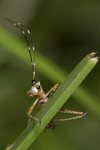 Cropped |
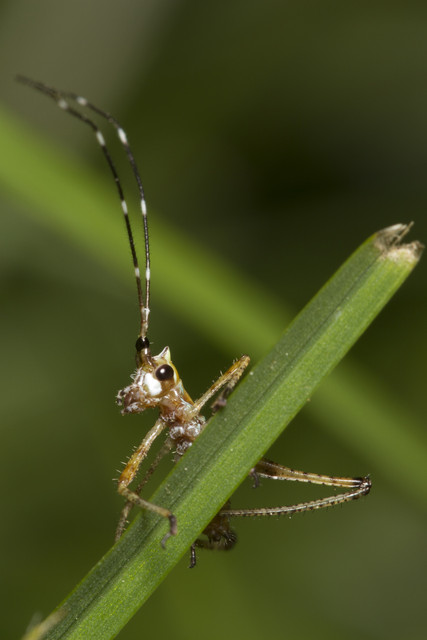 |
|
Technical Data: Canon EOS 7D, Canon EF 100mm f/2.8L Macro IS USM, 1/250 sec at f/11. Canon Speedlight 580EX II flash in auto mode and wireless control. Image Stabilization on. ISO 160. RAW processing in Adobe Camera Raw.
As usual, place your vote and then drop me a comment and let me know why you chose the one you chose.
- Bill
Katydid Nymph (part 2)
ktuli — Mon, 06/06/2011 - 19:54
Well, like I said, it was a short respite from the bug photos (sorry mom) and we're bouncing back to the katydid nymph from the other night.
This is another one from towards the end of the shoot when I was laying in the grass to get the low perspective to put the view in the katydid nymph's world. That's part of the allure of macro photography for me - to be transported to different worlds that exist right under our feet just by looking through the lens.
Technical Data: Canon EOS 7D, Canon EF 100mm f/2.8L Macro IS USM, 1/250 sec at f/16. Canon Speedlight 580EX II flash in auto mode and wireless control. Image Stabilization on. ISO 160. RAW processing in Adobe Camera Raw.
What Works: Again, a lot of the elements from the shot the other day work again here. The one added nice feature here that makes the shot a little more appealing is the fact that the front leg blocks the mouth parts a bit - I have to be honest and say that this little critter has some weird mouth parts that are probably a bit creepy to some folks, so getting them partially obscured probably is a good thing.
What Doesn't Work: Again here, the shot was taken on such a weird angle - technically the camera interpreted the shot as a vertical shot, but I rotated it back 90 degrees clockwise. The only problem with that is that the grass doesn't necessarily come from the bottom of the frame then. Again, another bright blade of grass in the background is a distraction.
If you like the bug shots, stay tuned as I have a couple more days worth to share. Thanks for stopping by.
- Bill
Posing Katydid Nymph
ktuli — Fri, 06/03/2011 - 16:19
Ok - we'll get back to the crab spider soon, I promise. But last night I went out to see about photographing the crab spider again, and happened to find this little guy...
Technical Data: Canon EOS 7D, Canon EF 100mm f/2.8L Macro IS USM, 1/250 sec at f/11. Canon Speedlight 580EX II flash in auto mode and wireless control. Image Stabilization on. ISO 160. RAW processing in Adobe Camera Raw.
Why This Photo: I've never seen a katydid nymph like this before, and I decided to spend some time with it to see what kind of good shots I could come up with. When I saw it climbing on this blade of grass, I figured a good pose would come of it, and when I saw it get into the classic tree-frog pose, I fired off a shot. I think it's a keeper...
What Works: First, the pose is the biggest thing here... I literally waited and worked with this katydid nymph for 35 minutes to get this shot. I also moved from position to position - starting on a peony flower, down to some hosta leaves, and finally down to the grass. To get the shot, I was laying on the ground so I could get an eye-level view of the katydid nymph. The focus is sharp, and the depth of field has almost the whole katydid nymph in clarity (except for the ends of the antennae).
What Doesn't Work: The bright blade of grass running the opposite angle in the background is somewhat distracting, and the white patch on the katydid nymph's face below its eye is a little over-powering (though that is how it was, so there isn't much I could do about it).
I think the main point from this is that I was rewarded by following some of those "rules" to photography. I worked with the subject to make sure I took multiple shots with multiple angles to provide myself with a higher possibility of scoring a nice photo. I also got down to eye level - even if it meant laying in the grass - so that the shot was engaging rather than flat. Finally I observed my subject and waited for that decisive moment to present itself.
I have more shots of this little guy, and I'll be sharing them and the crab spider shots next week. Thanks for stopping by.
- Bill
Getting Closer: Bug Macros
ktuli — Tue, 05/31/2011 - 21:21
I know they're not popular with most folks, but I really like macro photos - particularly of insects. I've really been trying to improve my techniques to get better macro shots, and recently, I managed to achieve some better shots that included macro focus that actually shows the multi-faceted eyes of the bugs I was shooting.
Technical Data: Canon EOS 7D, Canon EF 100mm f/2.8L Macro IS USM with Kenko Teleplus PRO 300 "DG" AF 2x Teleconverter, 1/250 sec at f/16. Canon Speedlight 580EX II flash in auto mode and wireless control. Image Stabilization on. ISO 160. RAW processing in Adobe Camera Raw. Full size.
Technical Data: Canon EOS 7D, Canon EF 100mm f/2.8L Macro IS USM, 1/250 sec at f/16. Canon Speedlight 580EX II flash in auto mode and wireless control. Image Stabilization on. ISO 160. RAW processing in Adobe Camera Raw. Full size.
It isn't easy to see in the resized versions, but in the full size versions, you can most definitely see the facets of the eyes on these bugs. Maybe some more work and I can nail these kinds of shots all the time.
Though I'm sure plenty of folks won't be pleased to see more bugs on the site...
- Bill
Trillium Trails: Red Velvet Mite
ktuli — Tue, 05/03/2011 - 20:41
As I was walking along, I was on the lookout for any bugs. At one point, I looked at this decaying log and saw this absolutely tiny bright red dot crawling about. I got down closer and noticed it was a bug of some sort - it had eight legs but didn't look like a spider.
I took maybe half a dozen shots, and ended up only keeping one (others were in focus and decent shots, but the subject was not facing the right way or didn't line up as well as this shot).
It turns out, this is probably a Red Velvet Mite. When I say it was tiny, I mean it. If my measurements and math are correct (using the Exit data saying that my subject distance was 0.29m which would be 1:1 magnification on my 100 f/2.8L lens), it was about 2.5-3mm long.
Below are the original and a cropped version. If you look closely, you can see an additional even tinier arthropod a small distance above the mite's front right leg (in the cropped version, it is just below the top edge of the frame).
Technical Data: Canon EOS 7D, Canon EF 100mm f/2.8L Macro IS USM, 1/250 sec at f/11. Canon Speedlight 580EX II flash in auto mode and wireless control. Image Stabilization on. ISO 200. RAW processing and cropped in Adobe Camera Raw. Trillium Trails, Fox Chapel, PA.
Sorry if that freaked anybody out, but I really like the challenge of working on such tiny subjects.
- Bill

